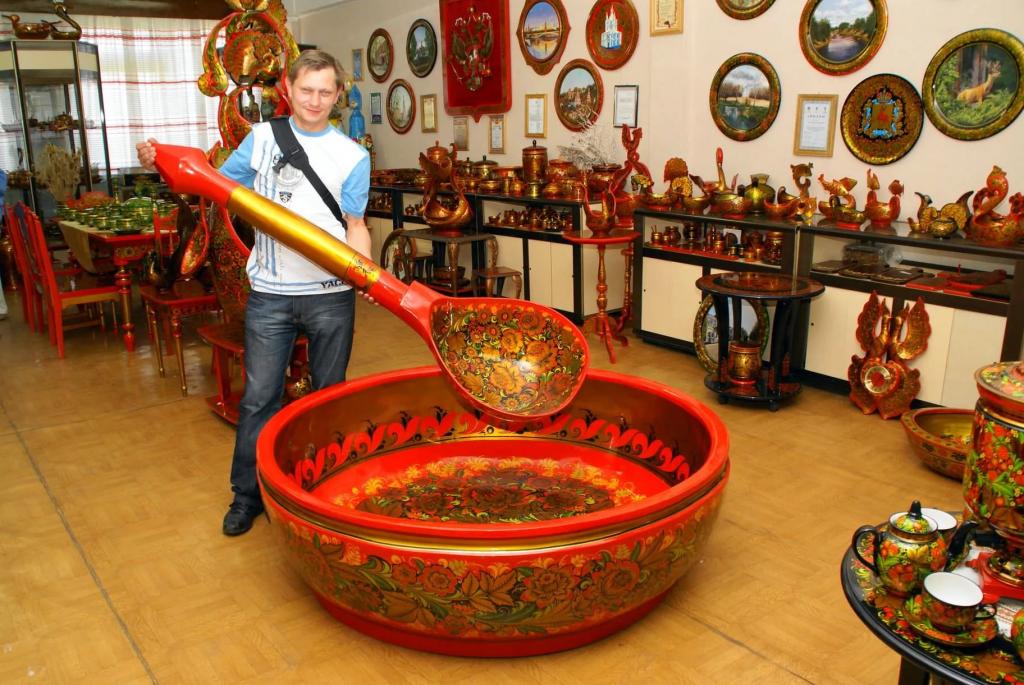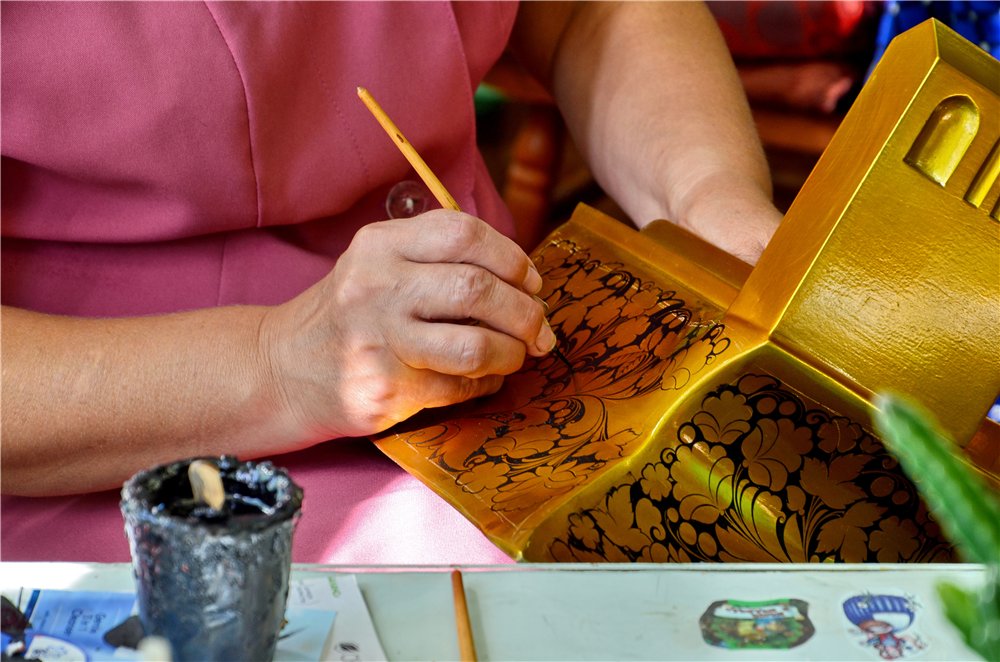The bright “golden” painting on wooden utensils known to every Russian citizen invariably attracts attention. It is difficult to imagine traditional Russian culture without such bright elements of national decor. Products decorated with intricate patterns are also popular abroad. This is the calling card of our national Russian craft.
The history of Khokhloma painting, as well as its distribution and significance in the modern life of the country are described in our article.
Types of murals
It is not in vain that they call the crafts, because they were invented by ordinary people. Almost every corner of Russia is famous for its special features and unique style in the work of craftsmen.
The history of the origin and development of Khokhloma painting is very interesting. However, there are other types. We represent the most striking, recognizable art crafts practiced in Russia:
- Gzhel. Perhaps the most recognizable element of decor in the world. Blue, airy, subtle patterns on a white background came to us from the 14th century. This kind of folk art has been an integral attribute of Russian culture for hundreds of years.
- Zhostovskaya. This is perhaps the most beautiful painting on metal household items. It is hard to imagine a Russian merchant house without a colorful tray or a samovar. We see on the black background whole works of art - bright flowers and fabulous firebirds. It seems they are ready to fly off the painted branches.
- Khokhloma painting. Also a very recognizable Russian craft. Bright golden leaves, rowan clusters, ripe red berries of strawberries, rowan, gooseberries on wooden utensils are popular not only in Russia, but also far beyond its borders.

- Gorodets painting from the town of Gorodets is recognizable thanks to its positive figures depicting ordinary Russian people. Toys and colorful little men in elegant sundresses and shirts always cheer up. This is a special genre of Russian applied art.
- Fedoskino lacquer miniature is a fun reflection of Russian life. Painting on caskets and snuff-boxes brings us back to the world of revelry, bazaars and holidays. Three horses race beautifully dressed men and women right to the center of the festivities.
Khokhloma painting
Its two essential elements are wood and gold. Today, such dishes are, first of all, decoration elements. Amazingly beautiful furniture, caskets, panels and paintings also harmoniously fit into the modern interiors of our apartments.
The history of Khokhloma painting has more than one hundred years. However, even now this type of folk art does not lose its relevance. How did such an amazing art appear in Russia?
A brief excursion into history
Previously, peasants used only wooden utensils. Spoons, bowls, jugs and ladles were standard kitchen utensils in any family. How did simple rustic dishes suddenly become a work of art? The history of the Khokhloma painting originates in the distant 17th century. The Khokhloma village of the same name that existed in the Volga region became its homeland.
The Volga region is a land rich in forests and picturesque landscapes. It was this unique flavor that became the subject of inspiration. The former Nizhny Novgorod province has always been famous for its craftsmen.
The history of Khokhloma painting is inextricably linked with other crafts of the Volga region. This region was famous for its wood carvings and the manufacture of various wooden objects. He is also famous for icon painters. There is an assumption that the golden color of the dishes was borrowed from these masters from the technology of gilding frames for icons. Then the craftsmen used silver powder, which covered individual details on their creations. When interacting with fire, silver turned into "gold", that is, it changed its color. It was this technology that artists began to use when painting wooden utensils.

The technique of applying Khokhloma painting is quite complicated. Silver powder was subsequently replaced with a more affordable material - tin. The painting was done before and is now done manually with resistant paints that can withstand heat treatment. First, the contours of the future pattern are applied. Then the background is filled with paint, according to which the stems of the flowers are brought out with a thin brush, they put bright strokes and dots. After drawing a pattern of red, black, brown and green paints, the product is varnished and sent to the oven. Varnish the work 5-6 times, each layer is carefully dried.
Stages of development
As noted above, there were many masters in the Volga region. Their secrets were passed down from generation to generation, contributing to the emergence of new professionals in their field. The history of Khokhloma painting, originating in the 17th century, began to actively develop. This was facilitated by a large number of masters and the constant interaction of crafts. The successful location of the region gathered at fairs a huge number of people from different cities. “Gold” dishes with red berries diverged very quickly, its popularity grew in all regions of the country.
The history of the development of Khokhloma painting was not without legend. She tells that in the 17th century, the glorious master Andrei Loskut fled from the capital to Khokhloma. He painted icons, but after the introduction of the canons of Patriarch Nikon, he decided to leave the capital city, since he did not like the new order. In the wilderness of the Volga, he began painting dishes. Nikon found out about this and sent soldiers to arrest Andrei. The master locked himself in a hut and burned himself, and before his death he bequeathed to protect his art.

At first, in Khokhloma and nearby villages, the dishes were made not as colorful and bright as we see now. The fact is that silver powder, which during processing became “gold”, was very expensive. As a rule, it was applied only as a fringing of products, the so-called belts. The bulk of the dishes was given using white. In the 19th century, they learned to make a golden background from tin powder. This material was cheap enough. Therefore, they began to use it for application to the entire product. All kinds of patterns were drawn on it. The whitewash is no longer used. At this time, there was a division of labor. In some villages, timber was harvested, in others, objects were cut from it, and in others (mainly in Khokhloma) they were painted, giving the final appearance of the products.
With the massive development of industry, handmade utensils were superseded by factory goods, which were much cheaper. Khokhloma painting was revived in the 20s of the last century. At this time, schools were created where they taught woodworking and drawing. Masters of Khokhloma painting more than once took part in international exhibitions. Thanks to their art, people of the whole world have gained the opinion that talented people live in Russia.
Modernity
Gold on a black background, decorated with scarlet berries and uncomplicated branches, was so fond of the Russian man that today is as popular as in past times. Some masters draw bright patterns on a red background or on a golden one. Subjects are always dedicated to nature. It can be not only plants, but also birds with bright plumage. Often in the plots, clusters of ripe berries or ears are used, talking about the wealth of their native land. Today they make not only such beautiful dishes. At exhibitions, we can even see cars painted with Khokhloma patterns.
Work examples
The history of Khokhloma painting can be briefly considered in everyday objects on display in museums. They give a clear idea of how this folk craft began, how it developed and changed. A rich assortment of dishes is always amazing. We see painted cups and mugs, plates of different diameters and deep bowls, salt shakers, barrels and jugs.
Currently, Khokhloma painting has become an element of high fashion. This is not only men's and women's clothing, but also all kinds of decorative elements. Bright Khokhloma patterns can be seen on phone cases, on women's jewelry and various interior items.
Khokhloma motifs in textiles also occupy not the last place. Masters use modern technology for applying their favorite pattern on almost any item. Those who wish can purchase curtains, bedspreads and bed linen in the Khokhloma style.
Khokhloma painting is actively used in furniture production. Many remember children's tables and chairs decorated with a familiar pattern. Today, cabinets, tables, chests of drawers and racks have become elements of the "Russian" interior.
For children
The history of the Khokhloma painting for children is very interesting. The straightforward and florid elements can be very informative for the younger generation. Learning the basics of folk craftsmanship is successfully carried out in circles for children. Kids are extremely interested in displaying bright leaves and berries on a black background.
A number of elements are used in the painting, which develop not only the skills of drawing, but also the imagination of little artists. Ornaments are changing. The result is beautiful pictures. Children not only draw patterns, but also directly paint objects, which is much more interesting for the development of creativity.
The history of Khokhloma painting for children explains how people used to imagine nature and how it was portrayed. Kids are taught to draw weed, droplets, bushes, berries, curls, tendrils, circles. Of these details, they make up patterns, painting paper spoons, plates, dishes.
Conclusion
Over the three hundred years of its existence, Khokhloma painting has not only not lost its relevance, but has also become much more diverse. Intricate ornaments and patterns are unique. This is our story, our distinguishing mark. Beautiful bright dishes with Khokhloma painting in a modern kitchen are always appropriate. It creates a feeling of comfort, fills the atmosphere with warmth and positive.